





Published on Nov 30, 2023
With the recent rapid growth of networked multimedia systems, digital watermarking techniques have widely been used in high security documents and for integrity checking. Digital watermarking is a technique to add hidden copyright notices or secret messages to digital audio, video, or image forms. This project was divided into two parts. In the first part, two watermarking algorithms "A novel image-hiding scheme based on block difference" and "Data Hiding in Images by Adaptive LSB Substitution Based on the Pixel-Value Differencing" have been studied and implemented on software. These two algorithms are both lossless image hiding techniques and produce good image quality of the stego-image. In the second part, FPGA was used to implement digital watermarking techniques with the video signal. Furthermore, Visual C#.net and Verilog HDL have been used to implement this project.
Today, audio, video, image or many other things can be represented in digital form. It is much easier for someone to make a perfect copy, which will lead to extensive unauthorized copying which may weaken the music, film, book and software publishing industries. Sometimes forgery digital media or documents become an important issue for identification, authentication and law enforcement. These concerns triggered many researches to find ways to hide the copyright messages and serial number into digital media. Digital watermarking is one of the data hiding techniques. There are diverse applications of digital watermarking -from counterfeiting and piracy deterrence, media management and identification and authentication to monitoring and mobile e-commerce. This project aims to develop digital watermarking device for authorization and copyright identification.
This project aims to develop digital watermarking device for authorization and copyright identification. This device consists of three components - a FPGA board, a VCD player and a display monitor. The VCD player provides the video signal to the FPGA. And the FPGA performs the watermarking process by encoding a watermark signal to the video signal in each frame securely and then transfer the video signal to the monitor.
1. Investigate feasible watermarking techniques that can be implemented in real time for document, image and video applications
2. Use Field Programmable Logic Gate (FPGA) to implement these watermarking techniques
3. Use video devices for testing the performance
This project is to develop a dedicated digital watermarking device based on FPGA, for implementing the watermarking algorithm to the video signal. The scope of work will include the followings:
1. Study the background of watermarking
2. Study the latest watermarking algorithm
3. Verify the watermarking algorithm with high-level language
4. Study the Verilog HDL syntax
5. Study the Xilinx XC2VP3O development board datasheet
6. Study the use of Xilinx ISE 8.0
7. Implement the algorithm by Verilog HDL
8. Study the video data format ITU-R BT656
9. Study the VGA timing
10. Configure the FPGA and show the watermarked image on VGA Monitor
The software using in this project includes Microsoft Visual Studio 2005, Hardware Description Language (Verilog), Matlab (for initial study), Quartus 6.0 (for initial study), Xilinx ISE 8.2i, while the hardware includes Xilinx XC2VP30 development board, Video Decoder 1 board, VCD player with NTSC standard, Video cable, Jtag cable, Monitor and the power cable of the board.
Digital watermarking means embedding information into digital material in such a way that it is imperceptible to a human observer but easily detected by computer algorithm. A digital watermark is a transparent, invisible information pattern that is inserted into a suitable component of the data source by using a specific computer algorithm. There are two type of watermark including Digital watermarks are signals added to digital data (audio, video, or still images) that can be detected or extracted later to make an assertion about the data.
Digital watermarking is a feasible method for the protection of ownership rights of digital media such as audio, image, video and other data types. The application includes digital signatures, fingerprinting, broadcast and publication monitoring, copy control, authentication, and secret communication. As a signature, the watermark identifies the owner of the content and can be used as a fingerprint to identify content consumers. For example, a specific watermarking technique is planned to be used to secure passports against counterfeiting in the United States. Broadcast and publication monitoring describes the area of computer systems which automatically monitors television and radio broadcast to track the appearance of distributed material. Several commercial systems already exist that make use of this technology. The watermark is often designed in such a way that any alteration either destroys the watermark or creates a mismatch between the content and the watermark, which can easily be detected.
Digital watermarks can be measured on the basis of certain characteristics and properties that depend on the type of application. These characteristics and properties include the difficulties of notice, the survival of common distortions and resistance to malicious attacks, the capacity of bit information, the coexistence with other watermarks, and the complexity of the watermarking method. In general, they are described as fidelity, robustness, fragility, tamper resistance, data payload, complexity, and other restrictions. Digital watermarks must fulfil the following requirements.
It may not be possible without knowledge of the watermark algorithm or secret key to remove the watermark or to make it illegible. Robustness means the resistance ability of the watermark against the watermark attacks or modifications made to the original file. After modifications, resizing, file compression, rotation, and common operations, the watermark can still be detected and demonstrate a good quality.
It means that the brought bit sample of the watermark does not produce perceptible changes acoustically or optically. A perfect non-perceptible bit sample is present if data material marked with watermark and the original cannot be distinguished from each other.
It is always true that brought watermark information in data material is non-detectable if it is consistent with the origin data.
The watermark must be hard to remove or even unable to remove by any attackers. Complexity: Complexity describes the cost to detect and encode the watermark information. One of measurement technique could be the amount of time. It is a good design to make watermarking algorithm and procedure as complex as possible.
Capacity refers to the amount of information that can be stored in a data source.
The extracted watermark is equivalent to the embedded watermark. A trade-off has to be taken between the above-mentioned criteria for an optimal watermarking application.
All watermarking techniques share the same generic build blocks: a watermark embedding system and a watermark decoder system. As for the above example, the secret image S embeds into the original image L through the encoder and watermarked image L’ is created. The secret image can be extracted from the watermarked image through the decoder. Different watermarking methods can be adopted in the encoder and decoder.
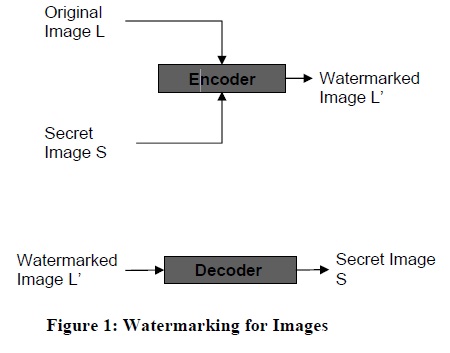
The XUP Virtex-II Pro Development System provides an advanced hardware platform that consists of a high performance Virtex-II Pro Platform FPGA equipped with a comprehensive collection of peripheral components that can be used to build up a complex system and to demonstrate the capability of the Virtex-II Pro Platform FPGA. As the project needs to process the video signal and this board contains the high-speed expansion connector which can be connected to the video daughter board using for the interface between the Development Board and the VCD player, this development board is suitable for using in this project. This board also contains the XSGA port which can output the video signal through the VGA cable to the monitor.
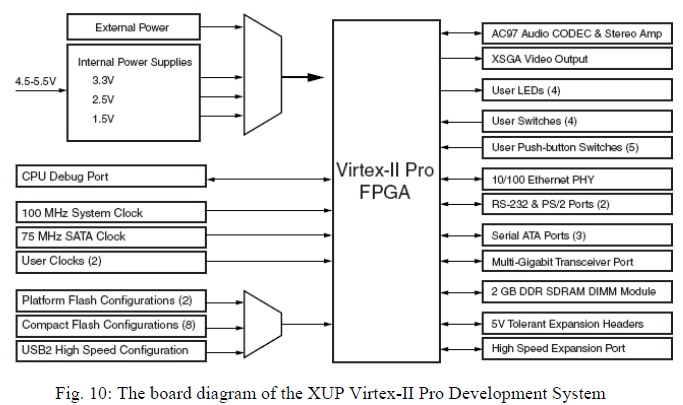
C# was used for implementing the algorithm’s evaluation in this project. As C#.net offers extensive support for Windows application development, it was quite simple for me to build up the user interface in the window form of the program. There are four watermarking algorithms selected for implementing in hardware:
1) A novel image hiding scheme based on block difference
2) Data Hiding in Images by Adaptive LSB Substitution Based on the Pixel-Value
3) Watermarking based on predictive neighbor pixels
4) 2 LSB substitution watermarking .
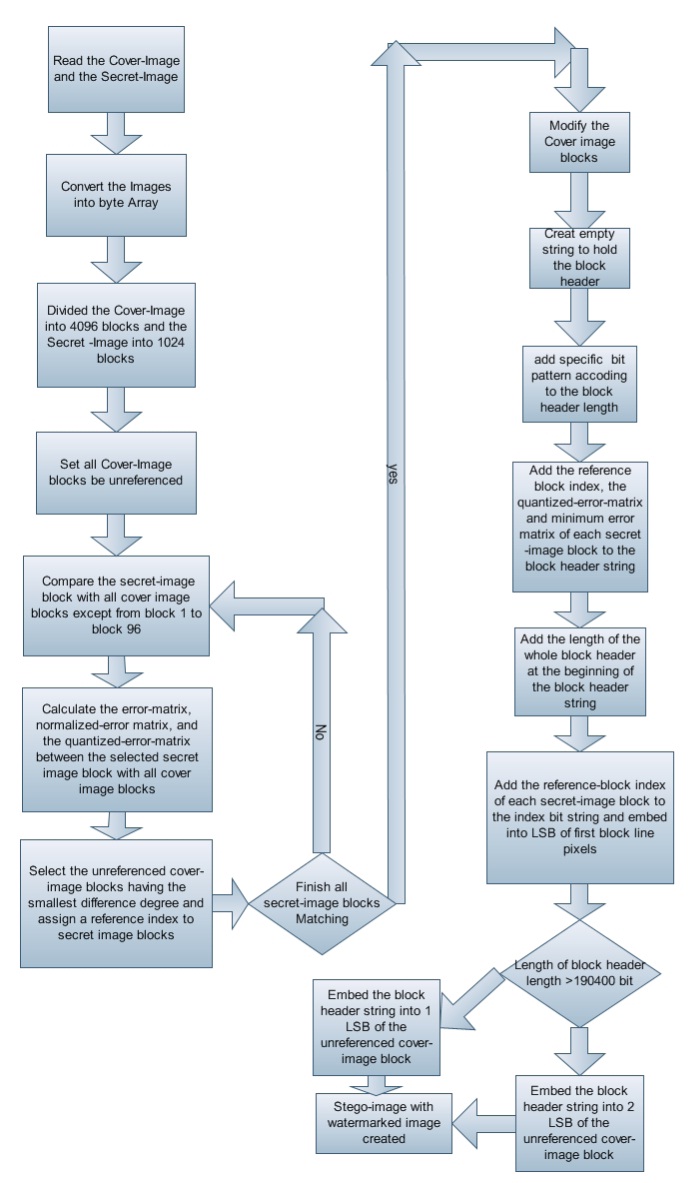
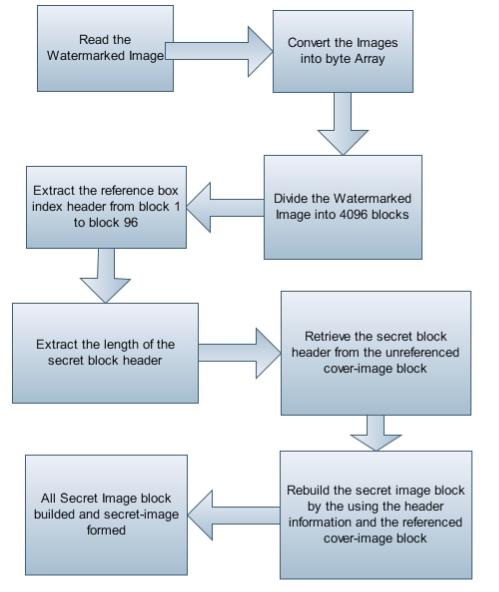
Since first two algorithms are quite complex in structure, they need to be verified by in software. Raw image file format will be used for cover-image and the secret image.
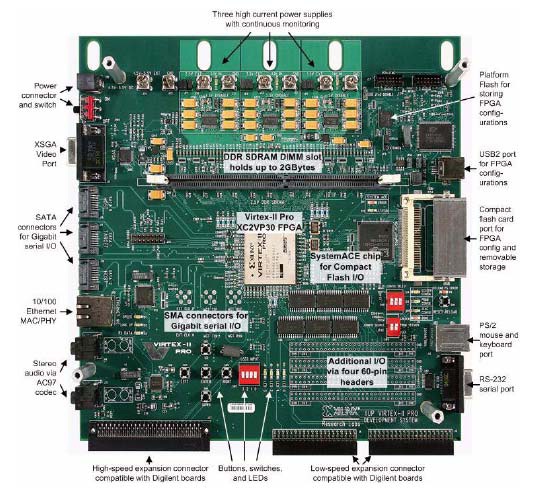
1) Xilinx XC2VP30 development board
2) The Video Decoder 1 board (VDEC1) with the ADV7183B Video Decoder chip
3) Video cable
4) VCD player with NTSC TV standard
5) Jtag cable
6) Monitor
7) Power cable of the board
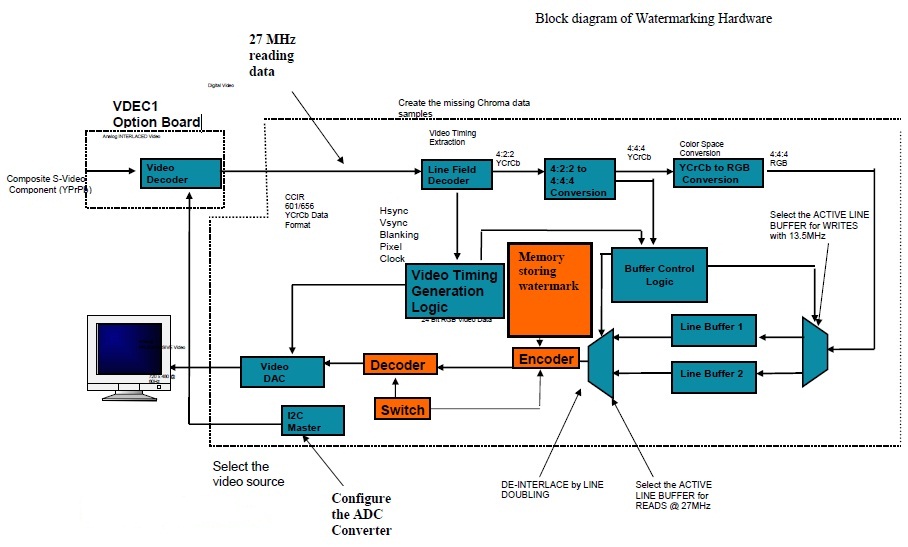
This project aims to develop a digital watermarking device for authorization and copyright identification. In this project, the VCD player will first transmit the video signal to the video daughter board connected to the FPGA through the video cable. Meanwhile, the computer will compile the verilog code and synthesis. After that, it generates the programmable file and then downloads the netlist to configure the FGPA board and the video daughter board. Then the FPGA will execute the watermark program and deliver the watermarked signal to the computer monitor though the VGA cable.
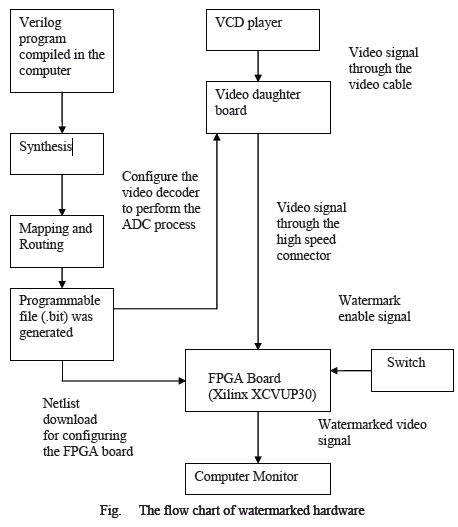
Appropriate algorithms have been selected to implement by hardware. Two of three watermarking algorithms have successfully been implemented in hardware.The hardware implementation of the digital watermark chip was completed. Moreover, future development into commercial chip is viable.